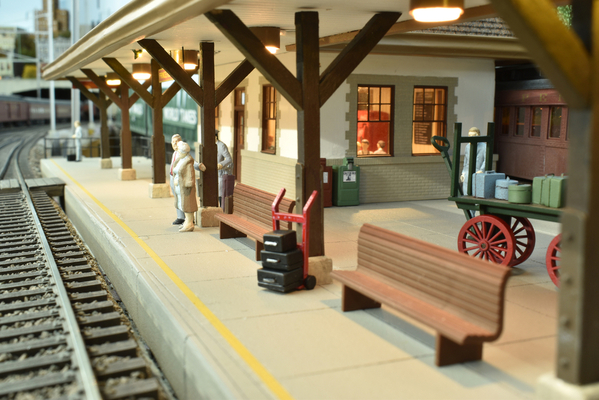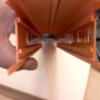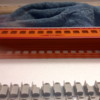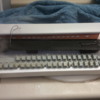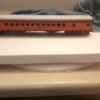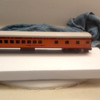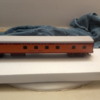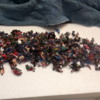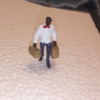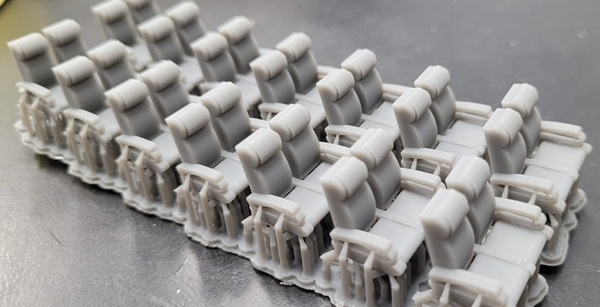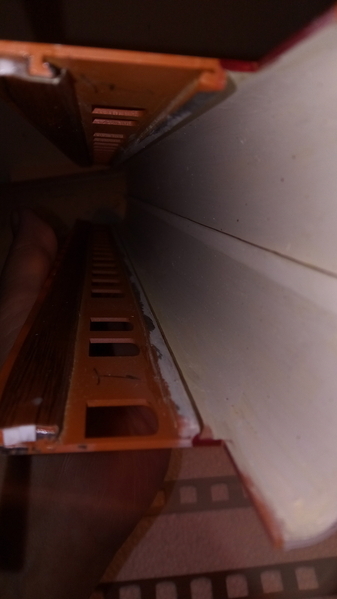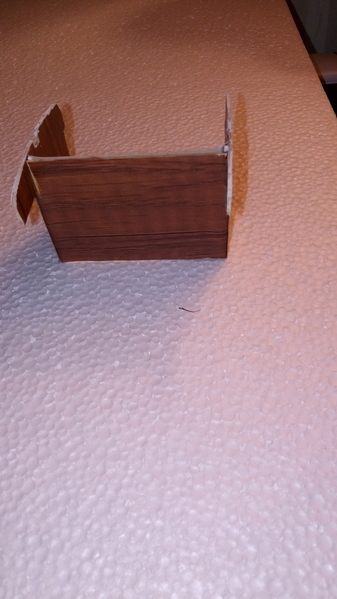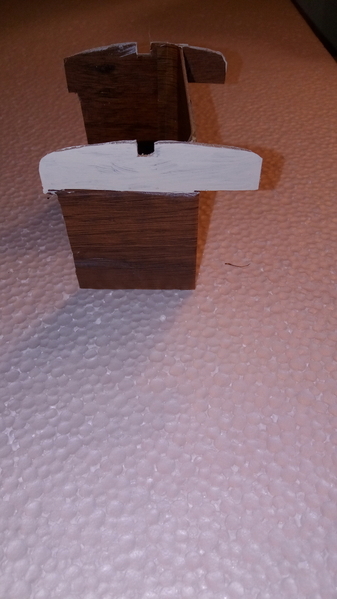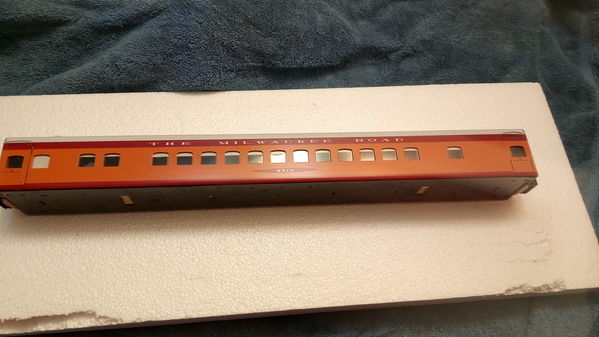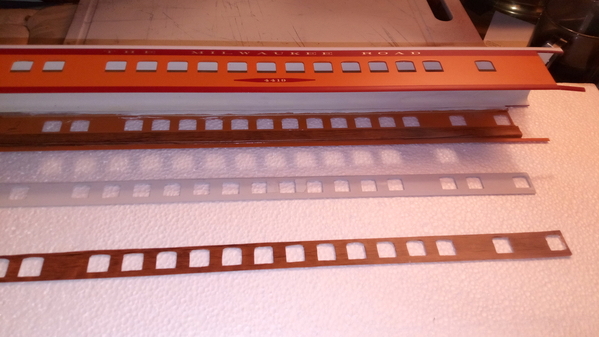Up grading , my Weaver Hiawatha cars to full detailed Scale from trucks to roof vents, and a complete interior for each type of car. To date I have painted about 350 figures including crews for 2 trains, and now working on interior details. My question is on luggage rack s and luggage , have you added this detail? have you made your own , do you have a vendor ?
Replies sorted oldest to newest
Would love to see some photos!
@Dave Koehler posted:luggage , have you added this detail?
Try looking at Berkshire Valley and Scale City Designs.
Yes, l also would always love to see pictures of Milwaukee Road.
Ray
@Dave Koehler posted:Up grading , my Weaver Hiawatha cars to full detailed Scale fromtrucks to roof vents, and a complete interior for each type of car. To date I have painted about 350 figures including crews for 2 trains, and now working on interior details. My question is on luggage rack s and luggage , have you added this detail? have you made your own , do you have a vendor ?
Request: Provide a vendors list with contact/website info for the various parts you've purchased. The list would be a GREAT supplement to any photos you post.
Good luck with the project!
For luggage, I used styrene strips and rods. Cut to length, score the gap between lid and main part, add HO Scale grab irons, or simply bent brass wire, for handles:
Attachments
Additional sources for O Scale detail parts, Altoona Model Works and Hobbylinc.
Well , I woke up to more snow on the ground ( yes its May 1 ) and its a Dark Day both in and out of my Appt. I will try to post Pics on what I have so far, later today. Been back at my books and Photo's trying to pick up mor details, but more of that later
@John Sethian posted:
Hat boxes, almost forgot about those
@Pingman posted:Request: Provide a vendors list with contact/website info for the various parts you've purchased. The list would be a GREAT supplement to any photos you post.
Good luck with the project!
will do
Here we go, this it the set I am starting with, the 1935/35 style cars made by Weaver for what they called the Morning Hiawatha, and compared to what's been done in other scales its not bad, just lacking a few details. the cars are aluminum extrusion's , with an annoying set of braces along the inside of the car sides for strength, and an injected floor with seating that has little to do with the Hiawatha style cars and will go down the road. When lit you can see a lot of the insides of the cars, including seats flooring walls and details above and beyond just the seated passengers and crew.
Attachments
I have a set just like that so following closely. Thanks for posting your progress.
This is what 332 seated figures looks like as well as 1 steward and the luggage I still need to come up with
Attachments
@Dougklink posted:I have a set just like that so following closely. Thanks for posting your progress.
do you have the 3 rail or 2 rail trucks?
3 rail. I'm planning to improve the lighting and replace the dark green window film with clear then add interior details.
I believe the ridges along the inside of the extrusion are for securing the end caps (top) window strips (middle of sides) and seating the extrusion on the floor stamping (bottom of sides).
The only place I've ever seen luggage racks being modeled was a video of a Japanese scratchbuilder showing how he builds HO scale coaches and electric multiple-unit cars from sheet brass. Not saying no O scalers have done it, but it would be a challenge locating examples of any who have, since most photos of superdetailed interiors wouldn't show them.
---PCJ
In no way did weaver design the seat insert for theses cars . they appear to be from an injected molded cars. . The plastic glazing is held in by 2 sided tape , and really has nothing to do with ribs on the inside of the extrusion , my guess is that they may have been planed for a deferent car not the HI. The only real complaint I have is Weavers, dies have the body coming straight down and making a 90 degree into the floor , where as the prototype tappers at the bottom transitioning to a 2.75" radius where it meets the floor. No Biggie I don't think any one gets that right
Today was spent diving to 3 deferent cities for a trip of about 100 miles just to find the supplies I needed to start the new interiors for the coaches, styrene bass wire steel piano wire ( for the baggage racks) and bass wood for the floor and walls for the men's and women's smoking lounges and 2 water closets for the coach seats I have come up with #28-255 from Scale City Designs as well astheir#48-3017 resign seats for the lounge and beavertail lounge cars . I haven't figured out the smoking lounge seating yet. Trying to figure out lighting , the lighting board supplied by Weaver give it a nice warm Glow , ( as the period 1930's had) but proto type had an odd shaped fixture, that's attached to the column between each window above the window line.. as far as interior color's the ceiling is Ivory , the wall were paneled with a imported South American Mahagany . ( Note , not brown and flesh colored, as described in some books ) I have no Idea on what to do on simulating the paneling, so any Ideas would help!
The pic show my color test , The colors described were Rose , Moss green , and Cranberry. and were described as very "High end plush, Spared no expense "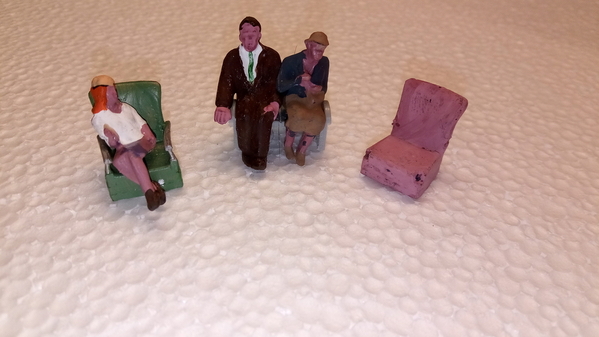
Attachments
@Dave Koehler posted:......paneled with a imported South American Mahagany . ( Note , not brown and flesh colored, as described in some books ) I have no Idea on what to do on simulating the paneling, so any Ideas would help!
Midwest used to sell 1/32" thick cherry and mahogany 3" sheet wood. Have not looked for it in many years....have to take a look to see if I have any left.
@Dave Koehler posted:Today was spent diving to 3 deferent cities for a trip of about 100 miles just to find the ...snip...
Diving?? I hope that you did not have to spend too much time decompressing. ![]()
@PRRMP54 posted:Diving?? I hope that you did not have to spend too much time decompressing.
I uses to have a secretary type for me, I need her back...LOL
Dave
If you want the .stl file for these let me know.
The FormLabs 3+ printer cost was reduced to $2499. as an owner I can get you another $500 off that price.
Attachments
@AlanRail posted:
too modern
hardwood suppliers may have the wood veneer you're looking for. usually about 3/64" thick.
@Pingman posted:WOW!!!
yeah, they look great! just the wrong style for my cars
@mwb posted:Midwest used to sell 1/32" thick cherry and mahogany 3" sheet wood. Have not looked for it in many years....have to take a look to see if I have any left.
Found cherry , as well as other veneers, now just wondering about the size of one to one woodgrain in a 1/48th interior. also still questioning the material thickness with the inside ribs of the car extrusions they take up about 6mm
So I know you really want to have an authentic appearance but that's not real luggage and they are plastic people with painted on clothes. So can't the paneling be something printed onto vinyl? Say a brown vinyl with wood grain lines printed onto it? It's really just background for all the other cool stuff people are seeing through the windows.
@Dougklink I was thinking the same thing. I rather think the wood would have tones and finish the other options just don't have. Think about laser cut wood buildings vs cast plaster vs molded plastic and its variations.
Yeah, the wood grain won't match but an observant viewer might recognize real wood and then not ever realize the mismatch in grain size. It might even be stunning to have distinct grain patterns - depending on placement in the cars.
I've schlepped around a shoe box size of sample veneers for nearly 60 years with little idea on what to do with them except as a reference to grain patterns. Now I have a use for those sheets.
The ideas we get on this forum ![]() !!!
!!!
ScoutingDad and Dougklink,I like your thinking on this. I have a piece and some printed paper / Vinal that I can try when it gets here this week. I do have.an on going issue . how would you remove the stiffening ribs on the interior car sides?
Attachments
I don't think you can remove them. You'll have to go for the look not perfection. Can you use the vinyl between the ribs above and below the windows with seperate pieces and then another in the window areas? That seems like the only doable thing to me. For this type of car construction anyway.
@Dave Koehler posted:how would you remove the stiffening ribs on the interior car sides?
Might be able to mill those out if you block the body shell carefully and make a lot of shallow passes.
But, if those are there for stiffening, might removing them result in a different problem?
@mwb posted:Might be able to mill those out if you block the body shell carefully and make a lot of shallow passes.
But, if those are there for stiffening, might removing them result in a different problem?
Removing the stiffeners them selves , would have no effect , the metal is stable and thick enough, But there is not a week that goes by that I dont miss my Mill , but at 700lbs they dont move well
@Dave Koehler posted:Removing the stiffeners them selves , would have no effect , the metal is stable and thick enough, But there is not a week that goes by that I dont miss my Mill , but at 700lbs they dont move well
Well, if that's not a problem then, reliance upon the kindness of strangers with a mill might be a viable option. But not the sort of shop tool I possess.
Well, how about covering them with paper - kind of like the head liners in cars, or planes for that matter. Sides can be paneled. The only thing I am scratching my head over is around the windows.
Paper or wall paper samples whether paper or vinyl.
Well the first of the printed paper came in, , spent 5 hours , tying to cut down those ribs for a total of 1mm. ( not good )
I used 2.5mmx 2.5mm square stock to fill in the gap from the floor rail to just below the window rail. For the gap where the window glazing sits , I cut 2 pieces of 1.75mm bass wood, traced the widows from the out side of the car, cut each one out for each side of the car , primed and sanded them. I reinstalled the plastic using paper masking tape to simulate the shades , applied the vinyl shelf paper to the window inserts , Sprayed testors clear coat over the car body to give it the proper shine (they were painted in gloss, not flat paint ) Then pressed the window inserts to the inside of the car.
What are you guys using for lighting? Remember I'm dealing with a 1930s prototype,, the transition from the old heavy weight cars, to the first Lt. weight modern cars ever designed. so no florescent or in your face blue white LED's . How are you doing period lighting?




